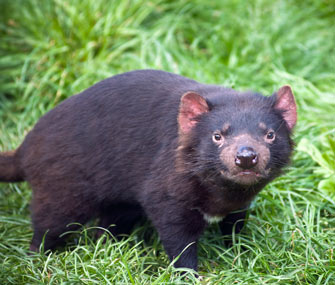Tasmanian Devils Threatened by Strange Cancer
Published on January 31, 2014

For those of us who grew up watching Saturday morning cartoons, Warner Bros.’ character Taz, the omnivorous, whirling, swirling cartoon caricature of a Tasmanian devil, was a delight. Already long on the endangered species list, however, the real Tasmanian devil (Sarcophilus harrisii) now risks extinction because of a strange form of contagious cancer.
A carnivorous marsupial about the size of a small dog, the devil is found only on the island of Tasmania, located off the southeast coast of Australia. The disease, which was first documented in the 1990s, has been killing the animals at an alarming rate. It attacks young devils at 2 to 3 years of age — long before they have an opportunity to reproduce. In areas where the disease has been found, up to 90 percent of the population has been decimated. The devils’ rapid decline has led to aggressive — but so far only marginally effective — efforts to save them.
Devils and Dogs: A Shared Risk
We do not typically think of cancer as being contagious, but dogs, like the devil, suffer from a contagious canine tumor: transmissible venereal tumor, or TVT. The disease has been around for 11,000 years. Devil facial tumor, or DFT — the cancer affecting Tasmanian devils — emerged in 1996 and is believed to have decreased the number of devils in the wild by more than half, with extinction predicted by 2024 unless a cure is found. Devil facial tumor is highly metastatic and always fatal. The dog is more fortunate; its transmissible tumor spontaneously regresses, or disappears, and renders the dog permanently immune to the disease. If a TVT lesion should cause a dog problems, it can be successfully treated with chemotherapy.
When Cells Run Amok
Devil facial tumor arose in an unknown Tasmanian devil many generations ago. Scientists describe the cancer cells in both DFT and TVT as “clonal,” meaning that all the tumor cells are genetically identical, like maternal twins. However, the tumor cells differ vastly from normal cells. Normal Tasmanian devil cells have 13 chromosomes; devil facial tumor cells have 14 chromosomes. A similar situation exists in TVT in dogs. Normal dog cells have 78 chromosomes; TVT cells have 57 to 64 chromosomes.
Devil “Love” Transmits Cancer
To understand how the strange tumor spreads from devil to devil, one must understand a bit about Tasmanian devil behaviors. Male Tasmanian devils aggressively protect their females against other males. Protection requires “jaw wrestling” to drive off the unsuccessful suitors. In protecting his females, a tumor-affected male can spread the tumor to numerous other males. Devils also may nip each other during communal feedings.
Because the transmission of devil facial tumor occurs through biting, the tumors typically occur in the head and neck region. Autopsies performed on devils who have succumbed to the disease have found that many of the animals died from metastatic cancer that spread to organs throughout their bodies. Devils typically die within a few months of showing visible lesions, as the tumors usually interfere with the animal’s ability to eat and compete for food.
Why the cancer is so contagious is not clear. Some researchers think that, because of their limited genetic diversity, the devils’ immune system cannot recognize and destroy the invading cancer cells. However, the immune systems of devils affected by the tumor appear to work normally, adding to the mystery.
The general conclusion is that somehow the clever cancer cells have found a way to evade the devil’s immune response. In essence, they have become "stealth cells," wreaking unchecked havoc throughout the animals’ bodies.
Treatment Isn’t Promising
Recently, a team of Australian scientists, including veterinary oncologists, investigated the use of a chemotherapy drug successfully used in the treatment of TVT in dogs in Tasmanian devils with facial tumor.
True to their pugnacious nature, the devils tolerated treatment with the drug vincristine at doses much higher than are given to dogs, cats or humans. However, despite their ability to withstand the drug’s toxic effects, no evidence of tumor regression was shown. Hope, for the moment, remains in isolating healthy populations and in the possible future development of an effective vaccine.
Ambassador Tasmanian Devils
We Americans are doing our part to help save the endangered species. Four healthy Tasmanian devils recently swirled into the San Diego Zoo.
Another four have recently taken up residence at the ABQ BioPark Zoo in Albuquerque, N.M.
The devils, who are free of DFT, are part of the Save the Tasmanian Devil Program. They and other captive devils will form the foundation for the reintroduction of devils back into their native habitat should wild devils become extinct because of DFT.
If you happen to be in San Diego or Albuquerque, you can meet the ambassador devils in the zoos’ Australian exhibits. Other top-quality U.S. and international zoos also have been selected as potential “safe sites” for future Tasmanian devil populations. Hopefully, such efforts eventually can help the feisty but endearing “Taz” survive a formidable health challenge.
More on Vetstreet.com:
- Video: Baby Tasmanian Devils Get Exams
- 7 Animals With Very Long Life Spans
- 7 Things Pet Owners Do That Drive Veterinarians Crazy
- How Old Is My Pet in People Years?





